The Leibniz-IZW is an internationally renowned German research institute. It is part of the Forschungsverbund Berlin e.V. and a member of the Leibniz Association. Our goal is to understand the adaptability of wildlife in the context of global change and to contribute to the enhancement of the survival of viable wildlife populations. For this purpose, we investigate the diversity of life histories, the mechanisms of evolutionary adaptations and their limits, including diseases, as well as the interrelations of wildlife with their environment and people. We use expertise from biology and veterinary medicine in an interdisciplinary approach to conduct fundamental and applied research – from the molecular to the landscape level – in close dialogue with the public and stakeholders. Additionally, we are committed to unique and high-quality services for the scientific community.
+++ Current information on African swine fever: The Leibniz-IZW conducts research on the population dynamics, on models of disease outbreaks in wild boars and on the ecology and human-wildlife interaction in urban areas. African swine fever is a reportable disease in domestic swine and therefor is the purview of the respective federal state laboratories and the Friedrich-Loeffler-Institut (Federal Research Institute for Animal Health) FLI. +++
News
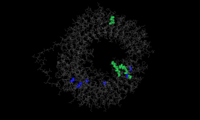
Bat immune receptors are one of a kind
An international team of scientists discovered that in bats Toll-like receptors, the first-line defence mechanism against invading pathogens, are different from other mammals. This suggests that the way bats recognise certain pathogens may be different than in other species and help explain why bats appear to suffer little from some pathogens which cause serious disease or mortality in other mammals. The study has been published in the scientific journal “Molecular Ecology”.
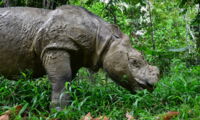
Hope for Asia’s wildlife: Reforestation measures and new wildlife corridors in Borneo
Owing to their high emission of CO2 and the destruction of large forest areas, the forest fires currently burning in Southeast Asia lead to an environmental disaster of unsuspected dimensions. One of the world’s most species-rich habitats is destroyed to clear land for new oil palm plantations. A ray of hope for Asia’s wildlife is presented by the agreement between the Rhino and Forest Fund (RFF) and the state government of Sabah, Malaysia, signed on 11th November 2015. The memorandum of understanding lays the foundation for urgently needed reforestation measures of degraded rain forest areas and the establishment of wildlife corridors. A further milestone is a donation of more than 460 ha of forest land to the Sabah Forestry Department on 11th November 2015, which has been initiated by the RFF. The land will be declared as conservation area and will eventually serve as a wildlife corridor between already existing nature reserves.
Read more … Hope for Asia’s wildlife: Reforestation measures and new wildlife corridors in Borneo
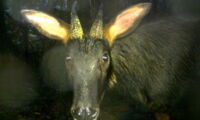
Standardised mammal surveys in support of law enforcement and measuring conservation success; an example from the Central Annamites
HUE, November 10, 2015 - From 10 to 11 November 2015, the German Leibniz Institute for Zoo and Wildlife Research (IZW) and WWF’S Carbon and Biodiversity (CarBi) programme will jointly host a workshop on the application of standardised biodiversity surveys in forests in Vietnam. Results from four protected areas, namely Bach Ma National Park, Quang Nam and Hue Saola Nature Reserves (Vietnam), and Xe Sap National Protected Area (Laos), will be presented and discussed by national and international scientists and stakeholders.
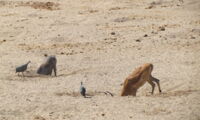
Why do animals dig waterholes?
Scientists from Berlin showed that animals in the Ruaha National Park in Tanzania, East Africa, already dig waterholes during dry seasons even if water is still available in the riverbed. When the river dries up and the water stops flowing, the water quality in the remaining pools deteriorates as they are contaminated with faeces and bacteria. In order to gain clean drinking water the animals have to find new water sources. The study has been published in the scientific journal „Mammalian Biology“...
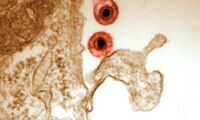
Herpes viruses with an unusual broad host range
In general, herpes viruses are considered to be specific to a single species or group of related animals. Recent research findings from the German Leibniz Institute for Zoo and Wildlife Research (IZW) contradict this assumption by showing that two equine herpes viruses (type 1 and type 9) have evolved an unusual broad host range. Despite favoring African herbivores these viruses can jump beyond their natural hosts, infecting polar bears and other distantly related species and causing fatalities. Interestingly, herpes virus type 9 (EHV-9) may use the African rhinoceroses as a possible natural host or reservoir. The findings were published in the scientific journal “PLOS ONE”...
%20andreas%20wilting_izw-qyrjxcb657yjqc2.jpg)
The future of the bornean orangutan – Impacts of change in land cover and climate
Dr Stephanie Kramer-Schadt and Dr Andreas Wilting from the Leibniz Institute for Zoo and Wildlife Research (IZW) are co-authors of the UNEP report on the future of the bornean orangutan. The report can be downloaded here (PDF size: 90,1 MB).
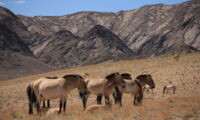
After 100 Years in Captivity, a Look at the World’s Last Truly Wild Horses
For the first time, an international team of researchers has sequenced the complete genomes of eleven Przewalski’s horses, including all of the founding lineages and five historical, museum specimens dating back more than a century. They compared these to the genomes of 28 domesticated horses to provide a detailed look at the endangered animals, both past and present. The current study has recently been published in the Cell Press journal “Current Biology”...
Read more … After 100 Years in Captivity, a Look at the World’s Last Truly Wild Horses
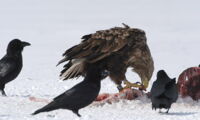
White-tailed eagles avoid large bullet fragments during consumption of carcasses
White-tailed eagles detect and avoid the ingestion of large metal particles (larger than 8 mm) but ignore smaller metal particles whilst feeding on shot mammalian carcasses. Lead-based bullets split into numerous small metal fragments when penetrating an animal’s body, whereas lead-free rifle bullets either deform without leaving any particles in the tissue or fragment into larger particles. Thus, the use of lead-free bullets may prevent lead poisoning of scavengers. These findings have recently been discovered by scientists of the German Leibniz Institute for Zoo and Wildlife Research (IZW) and are now published in the scientific journal “European Journal of Wildlife Research”...
Read more … White-tailed eagles avoid large bullet fragments during consumption of carcasses




